Downloads
Introduction
Thank you for inviting me to be here with you today to talk about the Indian economy.
For Treasury the Indian economy is a growing focus. In 2011 a senior Treasury officer commenced duty at the Australian High Commission in New Delhi.
We have also, just last week, had the pleasure of hosting a delegation from the Indian Finance Ministry for the Fourth Annual Treasury‑Indian Ministry of Finance Economic Dialogue.
We are increasing the resources we devote to monitoring India from Canberra and we are outreaching more to Australian business and academics engaged with India. In that context we welcome the opportunity to present at the India update and hope Treasury can be involved on an ongoing basis.
Today, I would like to share some of our thinking on India. In particular, I will talk about the re‑emergence of India and its potential to again become one of the truly significant players in the world economy.
I will briefly survey a number of challenges and tough reforms that will need to be addressed.
Finally, I will set out some of the growth areas for Australia in India, with a particular focus on those areas likely to benefit from the continued growth in India's middle class.
A remarkable transformation
Today India is the fourth largest economy in the world in purchasing power parity, or PPP, terms. But it hasn't always been thus.
Despite having the world's second largest population, in 1991 the Indian economy then ranked as the ninth largest in the world.
In 1991, the Indian economy was in turmoil, with the economy facing a current account crisis. On 24 July 1991, Manmohan Singh, then India's Finance Minister and now of course Prime Minister, embarked on a series of reforms that helped liberalise the Indian economy. These reforms included the relaxation of import and export restrictions, lessening of current and capital account restrictions, and an expedited removal of what many call the 'Licence Raj'.
These reforms went further than was needed to overcome the immediate crisis. They were instrumental in catalysing the transformation of the Indian economy that is now underway.
As is quite well known India performed well during the global financial crisis. Growth bottomed out at 6 per cent and then quickly recovered, although it has slowed again in recent quarters as the Reserve Bank of India has tightened aggressively to address inflationary pressures.
India's projected long‑term output path
Given India's scale the question of what the longer term holds for India is of truly global significance. It is certainly an immensely important issue for India.
We used the UN's long‑term population projections and a conditional convergence model to derive potential long‑term economic growth rates for the world's major economies and regions.
Chart 1: Working age population as a proportion of population
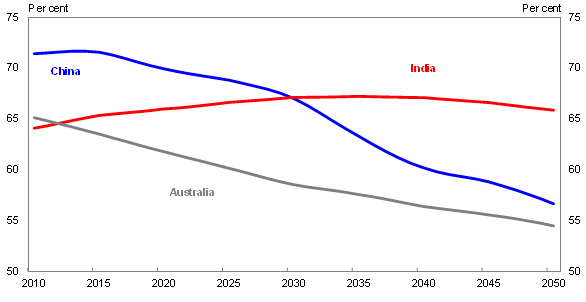
Source: UN population projections 2010 revisions and Treasury.
One of the key drivers of growth for India is population growth, or more importantly the projected growth of India's working age population. The proportion of people of working age in India is expected to increase steadily until about the middle of the 2040s and reach a peak at around 67 per cent.
This contrasts to many other countries, including Australia, and most notably China. This change in the composition of India's population has been called the 'demographic dividend'. It drives much of the projected future growth in India (Chart 2).
Chart 2: Long term projections — India, China, G7
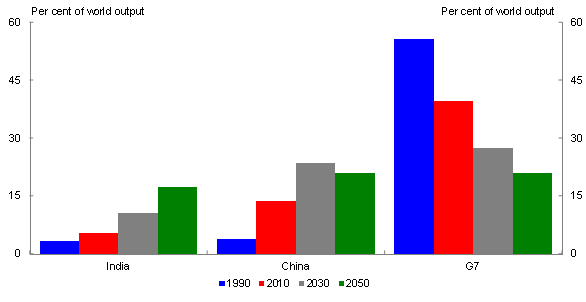
Source: Treasury, IMF and UN.
Chart 2 shows for India, China and the G7 economies and what could happen over the next 40 years. By 2050 on these projections India could account for over 15 per cent of global GDP.
Based on its stronger demographic fundamentals and on the strong productivity growth flowing from the convergence process India's potential growth rate could be faster than China's by the end of the current decade.
In terms of GDP per capita, in 2005, India's per capita GDP was about 5 per cent of the US. In 2050 it is anticipated to be around one‑third.
In level terms GDP per capita for India in 2050 is expected to be around where New Zealand or Korea are today.
Chart 3: GDP per capita — As a proportion of the US
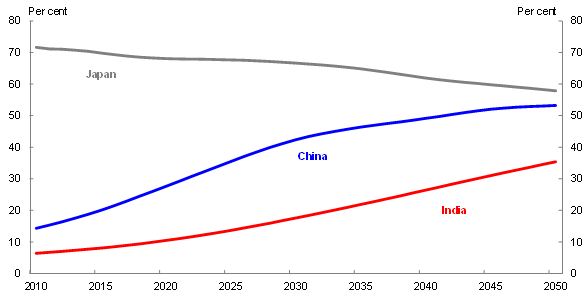
Source: Treasury, IMF and UN.
Of course, Treasury does not possess a perfect crystal ball. These projections are mechanical in nature and rely on demographic projections and assumptions about the productivity growth convergence.
They do, however, provide a clear guide to the extent of India's potential. The extent to which this potential is realised or exceeded will of course depend on the policies India adopts.
The broad policy challenges that I will briefly discuss centre around the basic factors of production, namely, population, land, and capital.
Population
Early next decade India is estimated to become the world's most populous country, with 1.4 billion people. By 2050, India is expected to have 1.7 billion people, while China is expected to be the next highest with 1.4 billion people.
Chart 4: Population — India, China
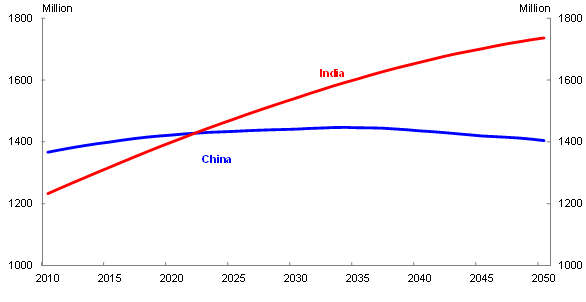
Source: UN population projections 2010 revisions and Treasury.
To put India's growth into perspective, between now and 2050 India's population is expected to grow by 485 million people. That is more than the present population of the US and Mexico combined.
Two immediate and interlinked challenges spring from this. First, how are all these people going to be fed? Secondly, what are these people going to do for a living?
Currently, India produces a lot of its own food. Imports of major food items are comparatively low. Moreover, while approximately 50 per cent of the working population are employed in the agricultural sector, agriculture only generates 15 per cent of GDP.
India's agricultural productivity is very low by world standards. In order to ensure that these additional people can be fed, India's domestic agricultural productivity has to improve dramatically or a far greater share of food will need to be imported. The more likely scenario is that there will be some combination of the two. This will require both concerted productivity improvements on the one hand and a loosening of trade restrictions on the other.
The opportuni
ties to improve productivity stem from improved practices in land use and rehabilitation, water efficiency and quality, crop and herd management, the mechanisation of agriculture, and upgrading of the logistical supply chain.
There is also the issue of how and where these extra people are going to be employed. India cannot continue to have 50 per cent of the working population in the agricultural sector.
Part of the solution to finding these extra people jobs lies in education and labour market reform.
Education and labour market reform
The number of people between the ages of 5 and 14 in India, is roughly 250 million. Putting aside higher level education, even ensuring that enough people are provided with basic primary school education is a challenge, but it is a challenge that India is winning.
According to census data, literacy rates have been improving. In 2001 literacy rates were roughly 65 per cent, while the 2011 census shows that the literacy rate is 74 per cent.
Unfortunately this higher literacy rate is yet to feed through significantly to labour market participation rates, with India's participation rate comparing unfavourably to China (Chart 5).
Chart 5: India and China participation rates
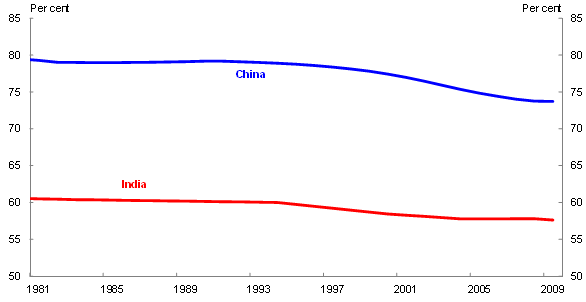
Source: International Labour Organisation.
One reason for the low participation rates and lack of formal job creation is the myriad labour laws that inhibit labour market flexibility and act as deterrents to growth in the formal sector.
In 2007 the OECD noted that employment in firms with more than 10 employees accounted for around 3 ¾ per cent of total employment. This was lower than any OECD country and suggests India is failing to take advantage of the massive scale economies it has on offer.
A major reason for this is that manufacturing plants with 100 employees or more require government permission to lay off just one worker. There is also the plethora of various state and federal laws that combine to make the system quite complex.
The impact of labour laws on India's economic performance is beginning to be debated. Last year India's Prime Minister questioned whether such laws, designed to protect workers, might actually be doing more harm than good.1
It seems clear that India's outdated labour laws are one of a number of factors holding back growth of the formal sector.
The success of Special Economic Zones, which are relatively less regulated and taxed, and the growth of the IT sector, which is less regulated, are indicators that productivity enhancing reform is possible.
Land reform
Land reform is often a vexing policy issue for densely populated emerging economies.
Currently, in India, there is a restriction on the maximum size of land that can be held. However, this restriction has seen an increase in the amount of smaller holdings of land as land is split among siblings over generations. Between 1960‑61 and 2002‑03 the share of households engaged in agriculture with land holdings of less than one hectare increased from 30.5 per cent to 80.4 per cent (Table 1).
Table 1: India's Rural Land Distribution (millions)

Source: National Sample Survey Organisation and Reserve Bank of Australia.
These small holdings make it difficult for the owners to make a living soley from working their land. In addition, with such small holdings capital investment is difficult, which inhibits productivity increase.
Beyond the agricultural sector, land reform is a key issue in the context of industrial and infrastructure development. Land acquisition issues are a factor behind the delays in many projects, and pressure for reform is building.
Capital
As most people who have been to India are aware, the need for enhanced infrastructure is overwhelming.
The lack of infrastructure is holding back India's economic development — with power shortages being a case in point. Other problems arise with respect to roads, water and sanitation.
However, it is interesting to note the relative vibrancy of the Indian telecommunications sector. Currently there are in excess of 850 million mobile phone subscribers.
India has identified early the potential of joint partnerships between local and international firms and is quickly developing expertise in public‑private partnerships (PPPs).
Implications for Australia
India's strong growth has already seen Australia's merchandise trade exports to India rise by nearly 800 per cent from 2000 to 2010. Put differently, this has added around $14.6 billion2 to Australia's annual merchandise exports and seen India rise from 14th to 4th most important merchandise export destination.
The strengthening trade relationship over the last 10 years has been largely the result of the growth in the Indian economy and its demand for resources. However, as growth in India continues and the middle class expands many more opportunities will expand and open up.
Resources
India's growing economy is leading to growing demand for energy commodities, such as natural gas and coal, and mineral commodities like gold and copper ore.
For example, coal exports to India for 2009‑10 were around $5.5bn. India is also expected to be a large customer of the $43bn Gorgon gas project in Western Australia.
Gold is also a very important export to India. Australia's gold exports to India have risen from $2.7bn in 2005‑06 to be in excess of $7.1bn 2009‑10. India's growth has also seen Australia's copper ore and concentrates exports rise to nearly $1.2bn.
But the relationship has the potential to extend beyond simply buyer and seller. India itself has large proven deposits of its own. For example India has the fourth largest proven deposits of thermal coal in the world. Bauxite reserves are around 3.3 bn tons, 7.5 per cent of global reserves making India a net exporter of bauxite. Iron ore reserves stand at around 13.4 bn tons (fifth largest in the world) with a large percentage of it having high ferrous content.
This resource endowment has seen Australian companies undertake exploration activities. Earlier this year Rio Tinto received a social awareness award from the Federation of Indian Mineral Industries (FIMI) for its efforts.
However, there are still many restrictions in place that make such activities difficult. A freeing up of restrictions in the mining sector would be a significant boost for the Indian economy. It would also provide Australian companies, who have the proven expertise and equipment to develop such deposits, a significant opportunity.
But the relationship need not go only one way. As we know, Australia itself has substantial resource deposits and Indian investment in our resource and energy sector is growing strongly. For example, Adani Group has acquired from the Queensland Government a 99‑year lease for the Abbot Point Coal Termin
al north of Bowen.
Agriculture
India's demand for agricultural commodities and processed food items is generally outstripping its domestic productive capacity. Increasingly India is looking to global supply chains to fill the gaps, which will boost trade flows. But there is also enormous untapped potential onshore.
India's agricultural productivity is very low by world standards. There are opportunities to improve practices in land use and rehabilitation, water efficiency and quality, crop and herd management, the mechanisation of agriculture, and upgrading the logistical supply chain. These opportunities should be attractive to Australian agribusiness, environmental and logistics firms.
India's agricultural sector will probably remain relatively heavily protected due to the political influence and poor economic and social conditions of agricultural workers.
But liberalisation has been occurring in the pockets of greatest need. The new opportunities can be seasonal and temporary as imports may only be allowed when there is a domestic shortage of production. Such opportunities can be large, however infrequent and unpredictable.
India's rising middle class presents opportunities of a different nature. As incomes rise and the Indian consumer has exposure to international markets, tastes are changing. This translates into growth in demand for protein, imported processed foods, wine and the like.
The liberalisation of FDI in India's multi‑brand retail sector could be an important force in helping to transform India's food sector — potentially boosting investment in the cold storage and supply chain, lifting agricultural productivity and incomes, and helping to alleviate food price inflation.
Infrastructure provision
India's physical infrastructure investment needs are also enormous, both to address a chronic shortfall in past investment, and to keep pace with the needs of a rapidly growing economy.
India's Planning Commission anticipates that average investment of around US$200 billion per year will be required in the next five year plan from 2012 to 2017, double the average of the current plan, to sustain India's growth. Some private estimates are higher still.
It is widely known that India has set itself ambitious targets for infrastructure and has tended to come up short. But that is an unduly negative take on the situation — solid progress is being made on many fronts, just as there is plenty of room for improvement.
In 2010‑11, 12,200 MW of electricity system capacity was added, up from 9,600 MW the previous year, but well short of the 20,000 MW target. However, power generation targets were broadly met in both years. The greater need comes in the transmission and distribution sectors, which are complicated by centre/state coordination problems, inadequate financial returns, and regulation.
Last year there were 1,780 km of national highways completed against a target of 2,500 km.
India's port capacity has also been expanding rapidly as it increasingly looks to engage globally, led largely by the involvement of the private sector.
There are Australian companies on the infrastructure financing side and on the construction and project management side supporting these efforts. But construction activity, and participation by the private sector, is really only just now ramping up.
India is actively seeking to modernise its PPP frameworks and attract foreign capital and know‑how. Again the opportunities and possible collaboration are significant, if the domestic policy settings and investment climate can be made more conducive.
Education
Currently around 11 million Indian students are pursuing higher education — but this represents just 11 per cent of the nation's 17‑23 year olds. The level of unmet demand for university places runs at around 4.7 million places each year.
And government policy is directed towards increasing the Gross Enrolment Ratio — the ratio of actual students to potential students — to 25 per cent by 2022.
To supply the necessary places, India intends to set up around 1,500 new higher education institutions, at least one central university in each state, and 14 new innovation universities.
The opportunities for Australian universities, whether in terms of partnering with Indian institutions during this growth phase or attracting more Indian international students to Australia are clear.
In terms of vocational education and training, the scope of opportunity is also impressive. The Australian Government has identified opportunities to increase the delivery of Australian vocational education and training (VET) qualifications in India.
At present only 2‑2.5 per cent of India's population undertakes formal VET training. But it is estimated that some 500 million people will require training by 2022 — over 21 times Australia's population. The current capacity of the Indian VET system is around 4.3 million training places.
The challenge for India is enormous and India recognises that it can't achieve these goals alone.
The scale of needs in India has seen our exports of education services to India experience roughly a 28 fold increase in dollars spent over the 15 years to 2010. These exports remain at very high levels and the whole trade is now of course on much more sustainable path after the Government's visa reforms.3 Also, the strengthening of the Australian dollar has had some impact.
Chart 6: Australia's exports of education services to India
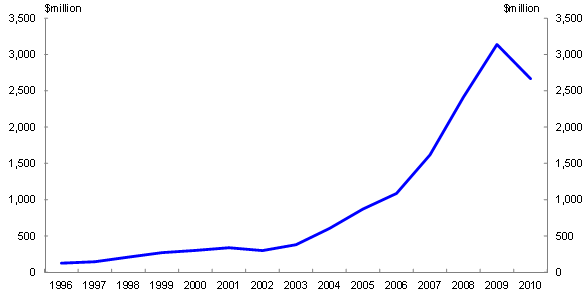
Source: ABS cat. no. 5368.0 and Treasury.
Tourism
India was the eleventh largest source of tourist arrivals in 2009, while China was fourth largest. As Indian incomes continue to rise there is much future growth potential. In addition, there is also scope for a change in the focus of visits from 'visiting friends and relatives' to 'holidays', which would increase the economic value from Indian tourism.
This growth in outbound Indian tourism will occur against a backdrop of increased competition among potential tourist destinations. How well Australia does in capturing this market will depend greatly on the skill and creativity of Australian tourism providers.
Summary
To summarise, the long term prospects for the Indian economy are very strong.
But India's policy makers must continue the reform process if India is to harness all of its growth drivers and achieve its enormous potential.
The rise of the middle‑class in India will open up many new opportunities for Australia, but our success is not pre‑ordained. Continued reforms to drive our competitiveness and a determined effort to better understand the Indian market will be essential.
The Australian Government will continue to work with our Indian colleagues both multilaterally and bilaterally to pursue strong reform outcomes, in the global interest and in our own national interests.
Thank you.
1 Indian Prime Minister Manmohan Singh's address to the 43rd Session of the Indian Labour Conference, 23 November 2010, see http://pmindia.nic.in/lspeech.asp?id=987.
2 All dollars refer to Australian dollars
, unless otherwise stated.
3 See Minister for Immigration and Citizenship press release 'Migration reforms to deliver Australia's skills needs' of 8 February 2010, see http://www.minister.immi.gov.au/media/media-releases/2010/ce10006.htm.